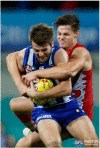Injuries in Australian Rules Football: An Overview of Injury Rates, Patterns, and Mechanisms Across All Levels of Play
- PMID: 28825878
- PMCID: PMC5958447
- DOI: 10.1177/1941738117726070
Injuries in Australian Rules Football: An Overview of Injury Rates, Patterns, and Mechanisms Across All Levels of Play
Abstract
Context: The nature of Australian rules football (Australian football) predisposes both unique and common injuries compared with those sustained in other football codes. The game involves a combination of tackling, kicking, high-speed running (more than other football codes), and jumping. Two decades of injury surveillance has identified common injuries at the professional level (Australian Football League [AFL]).
Objective: To provide an overview of injuries in Australian rules football, including injury rates, patterns, and mechanisms across all levels of play.
Study design: A narrative review of AFL injuries, football injury epidemiology, and biomechanical and physiological attributes of relevant injuries.
Results: The overall injury incidence in the 2015 season was 41.7 injuries per club per season, with a prevalence of 156.2 missed games per club per season. Lower limb injuries are most prevalent, with hamstring strains accounting for 19.1 missed games per club per season. Hamstring strains relate to the volume of high-speed running required in addition to at times having to collect the ball while running in a position of hip flexion and knee extension. Anterior cruciate ligament injuries are also prevalent and can result from contact and noncontact incidents. In the upper limb, shoulder sprains and dislocations account for 11.5 missed games per club per season and largely resulted from tackling and contact. Concussion is less common in AFL than other tackling sports but remains an important injury, which has notably become more prevalent in recent years, theorized to be due to a more conservative approach to management. Although there are less injury surveillance data for non-AFL players (women, community-level, children), many of these injuries appear to also be common across all levels of play.
Clinical relevance: An understanding of injury profiles and mechanisms in Australian football is crucial in identifying methods to reduce injury risk and prepare players for the demands of the game.
Keywords: AFL; injury prevention; injury surveillance.
Conflict of interest statement
The following authors declared potential conflicts of interest: Tanusha Cardoso is consulting as a sport and exercise medicine registrar at Alphington Sports Medicine Clinic, Victoria; John W. Orchard was the paid Injury Surveillance Coordinator for the Australian Football League for the period 1992-2014 inclusive.
Figures




References
-
- Australian Football League. AFL Injury Survey 2015. Melbourne, Victoria, Australia: AFL Doctors Association, AFL Physiotherapists Association, AFL Football Operations Department; 2015.
-
- Australian Football League. AFL player and match statistics. 2016. http://www.afl.com.au/stats. Accessed December 19, 2016.
-
- Australian Football League. Australian Football League Annual Report 2015. Melbourne, Victoria, Australia: Australian Football League; 2015.
-
- Australian Football League. Laws of Australian Football. Melbourne, Victoria, Australia: Australian Football League; 2016.
-
- Bradley T, Baldwick C, Fischer D, Murrell GA. Effect of taping on the shoulders of Australian Football players. Br J Sports Med. 2009;43:735-738. - PubMed
Publication types
MeSH terms
LinkOut - more resources
Full Text Sources
Other Literature Sources

